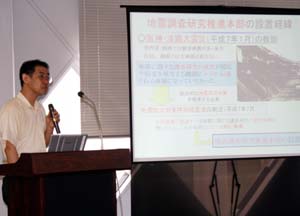「玄海の町長も、佐賀の知事も、時期が悪い」と不快感を示したようだが、そもそも、フクシマ県民が家を追われ、土地を追われ、放射能汚染の危険性に苛まれ、原発は今も収束のめどが立たずお手上げ状況に置かれているというのに、「国が責任を持つから」という経産相の言葉ひとつで、軽々に再稼働に賛同した首長の判断自体に大きな問題があったのではないか?
ブルームバーグによれば、日本はIAEAに提出した28項目の安全対策をクリアできないがために、そのかわりとして、「安全ではないという結果になるはずがない(工藤氏)ストレステストを実施して、それを原発再稼働を一気に推し進めるための切り札として使おうと考えているようだ。
しかし、欧米で使われているストレステストの調査項目や調査基準を、日本の原発の安全評価にそのまま使うことが果たして妥当なことと言えるのだろうか。
たとえば、地震や津波対策ひとつをとってみても、アメリカの内陸部や東海岸、EUにおいては、日本並の大地震・大津波対策は不必要であるが、地震・津波大国日本におけるアセスメントにおいては昨今の列島を取り巻く厳しい自然条件、高い人口密度、矮小な国土に十分みあった独自の安全基準を設け、それをクリアするものなのかを測定するものでないと全く意味がないのではないか。
電力会社や保安院や安全委員会など、相変わらずの懲りない面々が、自分たちに都合の良い基準を引っ張ってきて、これまでやってきたように内々で測定するのではなく、公正な立場にたってアセスメントができる小出裕章氏のような真の専門家に、その評価(当然のことながら、日本の自然条件などを十分考慮に入れたテスト項目の設定、アセスメント基準をどうするか等、根本的な議論も必要となるだろう)を委ねるべきではないのか。
以下 N.Y.Timesとブルームバーグの記事を転載する。
http://www.yomiuri.co.jp/national/news/20110706-OYT1T00926.htm?from=topwww.bloomberg.co.jp/apps/news?pid=90900001&sid=aaMTwWmrNtWs
全原発にストレステスト、地元への安全PRが狙い-焦点は玄海に
7月6日、経済産業省は原発の早期再開を促しているが、東京電力の福島第一原発事故で原発の安全性への不信感が高まっている中で、立地自治体説得に向けてテストを急ぐ方針を示した。
海江田万里経産相は6日朝、記者団に対し早期にストレステストを実施する必要があるとの考えを示し、定期点検が終わって再稼働できる状態になっている原発を優先させなければいけないと述べた。
3月11日に起きた福島第一原発事故以降、世界中で原発の安全性をテストする動きが強まっている。欧州連合(EU)でも6月からストレステストを実施している。地震や洪水、飛行機の墜落、爆発などに原発が耐えられるかどうかがテストの焦点。
九州大学の工藤和彦・特任教授(原子力工学)はストレステストで「安全でない」と判定される原発はないだろうとの見通しを示した上で政府は日本の原発が国際基準に合致しており地元に安全だということを示したいのではないかと述べた。
海江田氏は6月18日、全国の原発を検査した結果として、福島第一原発のような事故を繰り返さないような手段が取られているとの結論を下していた。
海江田氏は九州電力の玄海原発2、3号機について立地県の佐賀県、地元玄海町に対し再稼働を認めるよう求めた。同原発は定期点検を終えて4月には再稼働することになっていた。
6日の衆院予算委員会では海江田氏が6月18日に出した「原発安全宣言」をめぐって論戦が繰り広げられた。笠井亮議員(共産党)は海江田経産相の安全宣言はIAEA(国際原子力機関)に提出した安全対策28項目を取った上で行ったものではない」と指摘した。
これに対し、海江田氏は「28項目はしっかりやる。全部を直ちにというわけにはいかないが、欧州で行っているストレステストを導入してさらに多くの人に安心してもらうということだ」と答え、可能な原発は早期に再開していく方針を強調した。
菅直人首相は「保安院の判断、経産相の判断で再稼働できる法律になっているが、国民的にはそれだけでは納得してもらうことは難しいだろう。IAEAが欧州で提唱しているストレステストを含めて玄海だけでなく、全ての原発について将来的に共通のルールでチェックできるようにしてくれと指示を出した」と語った。
記事に関する記者への問い合わせ先:東京 稲島剛史 in Tokyo attinajima@bloomberg.net東京 渡辺千咲 in Tokyo atCwatanabe5@bloomberg.net
記事に関するエディターへの問い合わせ先:Chitra Somayaji in Hong Kong atcsomayaji@bloomberg.netAlexander Kwiatkowski in Singaporeakwiatkowsk2@bloomberg.net
更新日時: 2011/07/06 17:28 JST
Japan Plans Safety Assessments of Nuclear Plants
By MARTIN FACKLER
Published: July 6, 2011
The official, Trade and Industry Minister Banri Kaieda, said the so-called stress tests would measure the plants’ ability to withstand larger-than-expected earthquakes and tsunamis, like those that disabled the Fukushima Daiichi plant in March.
He said the analyses, which are modeled on those conducted by the European Union on its plants, were intended to give “a sense of assurance” to local residents.
The issue of local acceptance has come to the forefront in Japan as Tokyo tries to persuade regional leaders to allow the restart of dozens of reactors that were originally idled for regular maintenance, but that have not been turned on since the March disaster.
On Wednesday, the governor of southern Saga Prefecture, who will be the first to make the decision, said he would await the results of the new assessments before deciding whether to allow the restart of the two reactors at the Genkai nuclear plant. As the analyses are expected to take time to arrange and conduct, local media reports said that could postpone his decision until at least August.
At present, 35 of Japan’s 54 reactors are offline, some because of earthquake-related damage, but most because of the routine repairs. Under Japanese law, reactors must halt for repairs every 13 months.
Experts warn that if no reactors are turned back on, every reactor in Japan will be idle by April, possibly leading to power shortages.
However, the Fukushima accident has created a popular backlash against nuclear power. As a result, Tokyo faces an uphill battle trying to persuade regional leaders to give the necessary approval to restart their local reactors.


